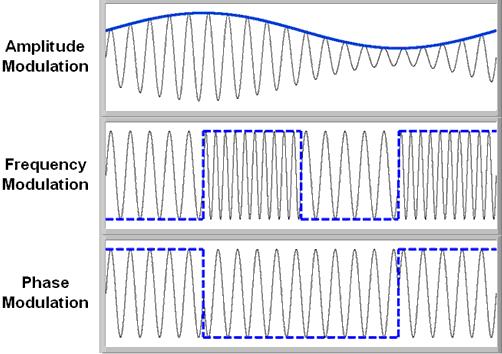Modulation, as above, is a process in which signals are transformed into different waveforms by changing basic properties. For instance, say we have a bit stream we want to send over the air. We can't just pulse 5V directly to an antenna to send the information. We must first modulate the signal into a usable RF signal somehow...
There are a number of ways to do this:
- Amplitude Modulation: The process of using different amplitudes to represent different values.
- Frequency Modulation: The process where we change the frequency to represent different values.
- Phase-Shift Modulation: The process where we change the phase of a signal to represent different values.
Courtesy National Instruments
There are many more but these are the basics. So we would have to come up with a conversion scheme for our digital stream. You would think this is the easy part (and in cases is) but the issue that arises is bandwidth.
Many times we must keep signals within certain FCC bandwidths. For example, I may have been allocated a certain bandwidth from 45.6MHz to 46.2MHz. If I transmit outside this range, I'm in trouble. So modulation will usually be based around this constraint first. After transforming the digital signal we would then modulate the signal onto a 46MHz waveform to stay within bounds. (Of course this is simplified)
Regardless, this is the basics of modulation from a systems point of view. From the circuits point of view we use mixers, PLLs, and oscillators.
Demodulation is just the inverse of this process. We will generally filter out the frequency we are looking for (so we don't get other garbage from the air) and reverse the process to retrieve the original signal.
That's it. Not much more about modulation/demodulation I can tell. It's crazy, I use it often where I work as an RF engineer, but I know so little...(I am new to the industry though).
Hope this is somewhat useful.
------------------------
Justin Coulston
justin.coulston@gmail.com

Your post really helped me to understand the Article. It has great details and yet it is easy to understand. I will definitely share it with others.
ReplyDeleteI'm glad you found it useful. Appreciate the comment!
ReplyDeleteJust Yesterday I'd to give a proposal presentation at my college on my project LASER COMMUNICATION SYSTEM. On the middle i was stopped and asked by supervisor "WHAT DO YOU MEAN BY PULSE FREQUENCY MODULATION" and I replied that it is to convert the electrical sinusoidal signal into logical signal same as Boolean algebra. He told me am totally wrong. Am I really wrong????
ReplyDeleteWell I'm not real sure the application but the first real form of modulation was Pulsed Modulation in use for Morse-Code. It basically would send out an RF signal at some frequency for a length of time and then turn off. This was not a boolean operation though. It was a language.
ReplyDeleteFor clarification, Modulation is when you turn "Data" into an RF Signal while Demodulation is the opposite "RF" into "Data."
It would be rather difficult to pulse sinusoids on and off and determine 1's and 0's from it unless it was timed (synchronized) in some way. Sorry to say but based on the information you provided you may have been incorrect in this.
Also, I'm not 100% sure about the Boolean Algebra comment without more clarification.